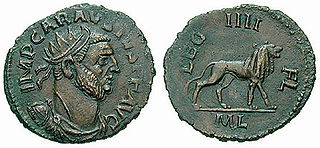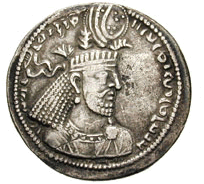Related Research Articles

Year 286 (CCLXXXVI) was a common year starting on Friday of the Julian calendar. At the time, it was known as the Year of the Consulship of Maximus and Aquilinus. The denomination 286 for this year has been used since the early medieval period, when the Anno Domini calendar era became the prevalent method in Europe for naming years.

Year 376 (CCCLXXVI) was a leap year starting on Friday of the Julian calendar. At the time, it was known as the Year of the Consulship of Valens and Augustus. The denomination 376 for this year has been used since the early medieval period, when the Anno Domini calendar era became the prevalent method in Europe for naming years.
Year 305 (CCCV) was a common year starting on Monday of the Julian calendar. At the time, it was known as the Year of the Consulship of Constantius and Valerius. The denomination 305 for this year has been used since the early medieval period, when the Anno Domini calendar era became the prevalent method in Europe for naming years.
The 330s decade ran from January 1, 330, to December 31, 339.
The 290s decade ran from January 1, 290, to December 31, 299.

Year 386 (CCCLXXXVI) was a common year starting on Thursday of the Julian calendar. At the time, it was known as the Year of the Consulship of Honorius and Euodius. The denomination 386 for this year has been used since the early medieval period, when the Anno Domini calendar era became the prevalent method in Europe for naming years.

Year 295 (CCXCV) was a common year starting on Tuesday of the Julian calendar, the 295th Year of the Common Era (CE) and Anno Domini (AD) designations, the 295th year of the 1st millennium, the 95th year and last 6 years of the 3rd century, and the 6th year of the 290s decade. At the time, it was known as the Year of the Consulship of Tuscus and Anullinus. The denomination 295 for this year has been used since the early medieval period, when the Anno Domini calendar era became the prevalent method in Europe for naming years.

Year 293 (CCXCIII) was a common year starting on Sunday of the Julian calendar. In the Roman Empire, it was known as the Year of the Consulship of Diocletian and Maximian. The denomination 293 for this year has been used since the early medieval period, when the Anno Domini calendar era became the prevalent method in Europe for naming years.
Year 277 (CCLXXVII) was a common year starting on Monday of the Julian calendar. At the time, it was known as the Year of the Consulship of Probus and Paulinus. The denomination 277 for this year has been used since the early medieval period, when the Anno Domini calendar era became the prevalent method in Europe for naming years.
Year 174 (CLXXIV) was a common year starting on Friday of the Julian calendar. At the time, it was known as the Year of the Consulship of Gallus and Flaccus. The denomination 174 for this year has been used since the early medieval period, when the Anno Domini calendar era became the prevalent method in Europe for naming years.

Year 307 (CCCVII) was a common year starting on Wednesday of the Julian calendar. At the time, it was known as the Year of the Consulship of Severus and Maximinus. The denomination 307 for this year has been used since the early medieval period, when the Anno Domini calendar era became the prevalent method in Europe for naming years.

Year 338 (CCCXXXVIII) was a common year starting on Sunday of the Julian calendar. At the time, it was known as the Year of the Consulship of Ursus and Polemius. The denomination 338 for this year has been used since the early medieval period, when the Anno Domini calendar era became the prevalent method in Europe for naming years.

Year 335 (CCCXXXV) was a common year starting on Wednesday of the Julian calendar. At the time, it was known as the Year of the Consulship of Constantius and Albinus. The denomination 335 for this year has been used since the early medieval period, when the Anno Domini calendar era became the prevalent method in Europe for naming years.

Year 316 (CCCXVI) was a leap year starting on Sunday of the Julian calendar. At the time, it was known as the Year of the Consulship of Sabinus and Rufinus. The denomination 316 for this year has been used since the early medieval period, when the Anno Domini calendar era became the prevalent method in Europe for naming years.

Year 219 (CCXIX) was a common year starting on Friday of the Julian calendar. At the time, it was known in Rome as the Year of the Consulship of Antonius and Sacerdos. The denomination 219 for this year has been used since the early medieval period, when the Anno Domini calendar era became the prevalent method in Europe for naming years.

Dai, also rendered as Tai and sometimes known in historiography as the Tuoba Dai, was a dynastic state of China ruled by the Tuoba clan of Xianbei descent, during the era of Sixteen Kingdoms. It existed from AD 310 to 376, with its capital at Shengle.
Tuoba Luguan, was chieftain of the Tuoba clan from 294 to 307. He was a son of Tuoba Liwei, the brother of Tuoba Shamohan, Tuoba Xilu, Tuoba Chuo. In 294, Tuoba Luguan became chieftain of the Tuoba upon the death of his nephew Tuoba Fu.
Tuoba Fu, chieftain of the Tuoba (293–294). He was the son of Tuoba Shamohan (拓跋沙漠汗) and the brother of Tuoba Yituo and Tuoba Yilu. In 293, he succeeded Tuoba Chuo as the chieftain of the Tuoba. His predecessor was his father's younger brother. Upon his death in 294, he was succeeded by Tuoba Luguan, another one of his uncles.
The Sixteen Kingdoms, less commonly the Sixteen States, was a chaotic period in Chinese history from AD 304 to 439 when northern China fragmented into a series of short-lived dynastic states. The majority of these states were founded by the "Five Barbarians", non-Han peoples who had settled in northern and western China during the preceding centuries, and had launched a series of rebellions against the Western Jin dynasty in the early 4th century. However, several of the states were founded by the Han people, and all of the states—whether ruled by Xiongnu, Xianbei, Di, Jie, Qiang, Han, or others—took on Han-style dynastic names. The states frequently fought against both one another and the Eastern Jin dynasty, which succeeded the Western Jin in 317 and ruled southern China. The period ended with the unification of northern China in 439 by the Northern Wei, a dynasty established by the Xianbei Tuoba clan. This occurred 19 years after the Eastern Jin collapsed in 420, and was replaced by the Liu Song dynasty. Following the unification of the north by Northern Wei, the Northern and Southern dynasties era of Chinese history began.

The Tuoba (Chinese) or Tabgatch, also known by other names, was an influential Xianbei clan in early imperial China. During the Sixteen Kingdoms after the fall of Han and the Three Kingdoms, the Tuoba established and ruled the Dai state in northern China. The dynasty ruled from 310 to 376 and then was restored in 386. The same year, the dynasty was renamed Wei, later distinguished in Chinese historiography as the Northern Wei. This powerful state gained control of most of northern China, supporting Buddhism while increasingly sinicizing. As part of this process, in 496, the Emperor Xiaowen changed the imperial clan's surname from Tuoba to Yuan. The empire split into Eastern Wei and Western Wei in 535, with the Western Wei's rulers briefly resuming use of the Tuoba name in 554.
References
- ↑ Roger S. Bagnall; Alan Cameron; Seth R. Schwartz & Klaas A. Worp (1987). Consuls of the Later Roman Empire. Oxford University Press. p. 122. ISBN 1-55540-099-X.
- ↑ Tucker, Spencer C. (2009). A Global Chronology of Conflict. ABC-CLIO. p. 153. ISBN 9781851096725.
- 1 2 Xiong, Victor Cunrui (2009). Historical Dictionary of Medieval China. Rowman & Littlefield. p. 515. ISBN 9780810860537.